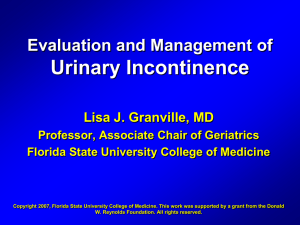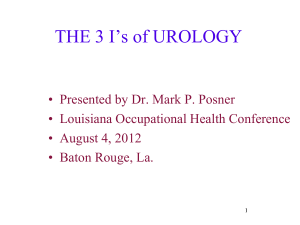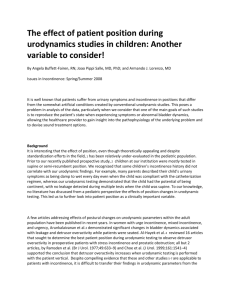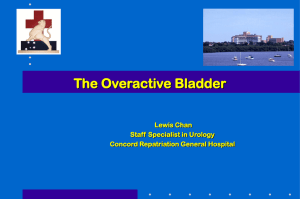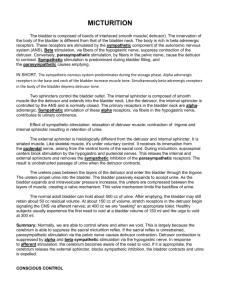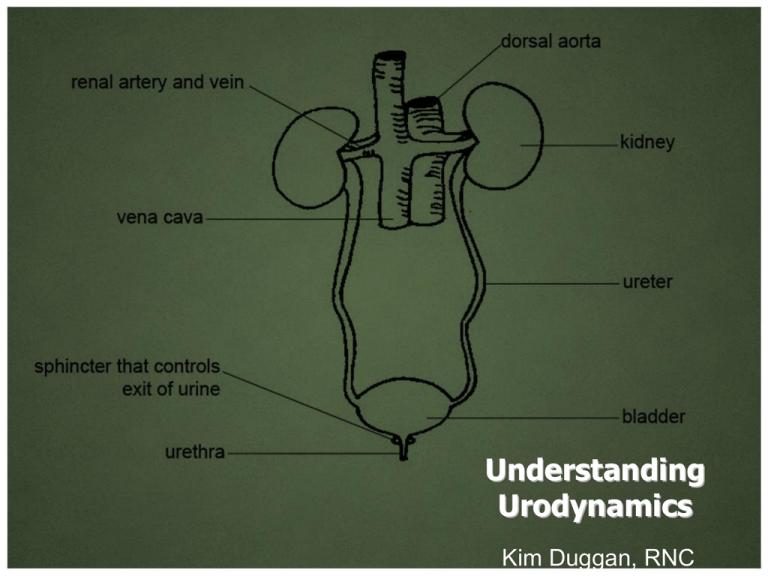
Understanding
Urodynamics
Kim Duggan, RNC
Understanding Urodynamics
• Urodynamics is a study that assess how the bladder and
urethra are performing their jobs of storing and
releasing urine
• Urodynamics testing assesses how well the bladder and
sphincter muscles work to explain symptoms
• Urodynamic testing tells the physician if the patient has
a Functional Problem or a Structural Problem
Patient Complaints
Incontinence
Frequent Urination
Sudden, Strong urges to urinate
Problems starting a urine stream
Painful urination
Problems emptying your bladder
completely
Recurrent urinary tract infections
Pelvic Pain
Contributing Factors to Incontinence
• We get older
• We loose our hormones
• We gain weight
• We carry children
• We give birth
• Our pelvic floor
weakens
Psycho-Social Issues with Incontinence
Urinary Incontinence Effects Quality of Life By:
• Fear of having urine odor
• Unable to Exercise
• Fear of Leaking in Public
• Life revolves around Looking for Restrooms
• Effects Traveling and Social Life
• Feelings of being unclean or dirty
• Effects Intimacy
• Expensive Undergarment Padding
• “I’m getting old” or “I’m too young for this to be happening”
Types of Incontinence
1. Urge Incontinence:
The sudden, intense urge to urinate, followed by a loss of
urine. Patients feel like they never get to the bathroom fast
enough. These patients are up several times a night with
the strong urge to urinate.
2. Stress Incontinence:
The unintentional release or leakage of urine during sudden
movements such as coughing, sneezing, laughing or
exercising.
Types of Incontinence
3. Mixed Incontinence:
Occurs when women have symptoms of both
stress and urge Incontinence.
4. Overflow Incontinence:
Occurs when the bladder doesn’t completely
empty. It may be caused by dysfunctional nerves
or a blockage in the urethra that prevents the
flow of urine.
URGE INCONTINENCE
• A sudden involuntary
contraction of the
muscular wall of the
bladder causing urinary
urgency, an immediate
unstoppable urge to
urinate.
A Functional Problem
Also known as
overactive bladder
or OAB or OAD
Treatment option:
Anticholinergics to
block the nerve
signals related to
bladder muscle
contractions.
Structural Problems
• Stress urinary incontinence
- accidental leaks when you
cough, laugh or sneeze - is
the most common form of
urinary incontinence in
women.
• SUI happens when your
sphincter, which acts like a
valve to the bladder, can’t
stay closed when there’s
pressure in your abdomen.
SUI is a Structural Problem
Steps to Diagnosis
Talk with your patients
• Gather symptoms
• Understand the emotional component
• Order a Urodynamic Study
A urodynamic study takes the guess work out of
diagnosing. It will absolutely define the
problem
Asking The Right Questions
“Do you leak with you cough, laugh, or sneeze?”
“Do you ever get the feelings of gotta go,
gotta go, gotta go!?!”
“Do you not always make it when you are racing for the
bathroom?”
“How many times do you get up during the night?”
“Do you feel a bulge?”
“Do you have to shift your upper body to urinate?”
The Urodynamic Test
The Uroflowmetry
• A uroflowmeter
automatically
measures the amount
of urine and the flow
rate—that is, how fast
the urine comes out.
• Then a Measurement
of Postvoid Residual is
obtained (PVR)
Cystometry
Abdominal Pressure Monitoring
• Another catheter will be placed in the rectum to
record pressure there as well.
• The bladder will be filled slowly with warm water.
• During this time you will be asked how your bladder
feels, noting sensation.
• The volume of water and the bladder pressure will be
recorded, noting capacity and compliance.
• You will be asked to cough or strain during this
procedure. Involuntary bladder contractions can be
identified.
Electromyography
• Electroymyography measures external
sphincter activity
• We obtain this measurement by placing EMG
leads on the anal sphincter
• The anal sphincter mimics the external
sphincter
• This allows us to see is that the external
sphincter is working in synergy with the
detrusor muscle.
Valsalva Leak Point Pressure
VLPP
• Measures the lowest
abdominal pressure
required during a stress
activity (such as coughing)
that would cause the
urethra to open and,
therefore,
leak.
This is where we are checking
for urethral competency
Pressure Flow Study
• This is the last step with
a urodynamic study.
• It determines the
amounts of detrusor
pressure required for
the patient to void
• A detrusor pressure less
than 30 is normal for a
female
What does a urodynamic test tell us
• Sensation
• Capacity
• Compliance
• Detrusor Activity
Capacity
• The amount of fluid that the patient can
comfortably hold
Compliance
• The ability of the bladder to expand and
accommodate urine at a low pressure
• There should be no more than one centimeter
of detrusor pressure for every 30 mls of fluid
infused
• Therefore, 300 mls infused volume, the
detrusor pressure should be 10 cm or less.
Sensation
• Evaluation of the following four sensation:
First Desire: First sensation of filling
Normal Desire: First urge to go to bathroom
Strong Desire: Stronger urge to go, but not yet
imamate
Urge: Cannot wait any longer for fear of
accidents
Detrusor Activity
• Normal- No contractions are seen during
filling phase
• OAD- One or more contractions during filling
phase, regardless of amplitude
Detrusor Activity
• Hyperreflexia –Poorly compliant bladder,
where the detrusor pressure “ramps up”
during filling phase
• Hypotonic- Highly compliant bladder, where
the detrusor pressure remains very low even
at capacity > 500 mls.
Detrusor Activity
• Areflexia- No detrusor activity at all, even with
attempt to void. Complete absence of
detrusor contraction
• Autonomic- Usually low volume, high
amplitude detrusor contractions with
complete bladder emptying
Understanding Urodynamics
• Information that we gather from a
Urodynamic Study is used to make a definitive
diagnosis and treatment plan

